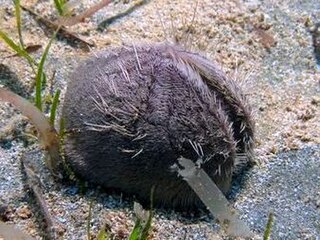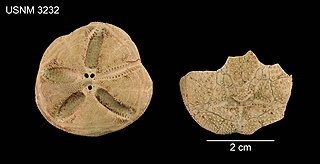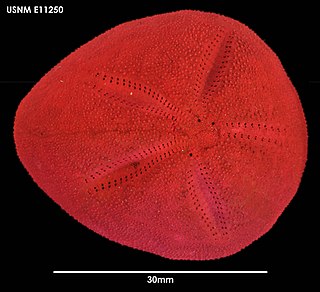The World Register of Marine Species (WoRMS) is a taxonomic database that aims to provide an authoritative and comprehensive list of names of marine organisms.

Agassizia is a genus of sea urchin of the family Prenasteridae. The species was first scientifically described in 1869 by Achille Valenciennes.

The heart urchins or Spatangoida are an order of sea urchins.

Temnopleuridea is an infraorder of sea urchins in the order Camarodonta. They are distinguished from other sea urchins by the presence of large fused plates on top of the feeding lantern. The test is usually sculpted to some degree, and has perforated tubercles.

The Echinacea are a superorder of sea urchins. They are distinguished by the presence of a rigid test, with ten buccal plates around the mouth, and solid spines. Unlike some other sea urchins, they also possess gills. The group is a large one, with species found worldwide.
Bela beatriceae is a species of sea snail, a marine gastropod mollusk in the family Mangeliidae.

Brachycythara is a genus of very small predatory sea snails, marine gastropod mollusks in the family Mangeliidae.

The Camarodonta are an order of globular sea urchins in the class Echinoidea. The fossil record shows that camarodonts have been in existence since the Lower Cretaceous.

Abatus agassizii is a species of sea urchin of the family Schizasteridae. Their armour is covered with spines. It is in the genus Abatus and lives in the sea. Abatus agassizii was first scientifically described in 1889 by Georg Pfeffer.

Abatus cavernosus is a species of sea urchin of the family Schizasteridae. Their armour is covered with spines. It is in the genus Abatus and lives in the sea. Abatus cavernosus was first scientifically described in 1845 by Rodolfo Philippi. Females brood their young in a brood pouch through the gastrula stage until they are juveniles.

Abatus cordatus is a species of sea urchin in the family Schizasteridae. It is native to shallow seas surrounding certain island groups in the southern Indian Ocean. The body is protected by a hard test or shell which is covered with spines. The female broods its young in deep pockets on the upper surface, retaining the young in place with specialised spines. American zoologist Addison Emery Verrill first scientifically described A. cordatus in 1876.

Abatus koehleri is a species of sea urchin of the family Schizasteridae. Their armour is covered with spines. It was first scientifically described in 1908 by Koehler. It is known from the South Orkneys.

Abatus ingens is a species of sea urchin of the family Schizasteridae. Their armour is covered with spines. It is in the genus Abatus and lives in the sea. Abatus ingens was first scientifically described in 1926 by Koehler.

Abatus philippii is a species of sea urchin of the family Schizasteridae. Their armour is covered with spines. It is in the genus Abatus and lives in the oceans of the southern hemisphere. Abatus philippii was first scientifically described in 1871 by Sven Lovén.

Abatus shackletoni is a species of sea urchin of the family Schizasteridae. Their armour is covered with spines. It is in the genus Abatus and lives in the sea. Abatus shackletoni was first scientifically described in 1911 by Koehler.

Sterechinus is a genus of sea urchins in the family Echinidae. All living members of the genus are found in the waters around Antarctica but the first species described in the genus was a fossil and was found in Europe.

Brachysternaster is a monotypic genus of sea urchins of the suborder Paleopneustina. Its sole accepted species is Brachysternaster chesheri, first scientifically described in 1985 by Larrain.

Goniocidaris umbraculum is a species of cidaroid sea urchin that inhabits the continental shelf off the southern coasts of New Zealand. It is plentiful on a seabed composed of seashell and bryozoan rubble at a depth of 95 m (310 ft) off Otago.

Abatus is a genus of sea urchins belonging to the family Schizasteridae.
Schizasteridae is a family of echinoderms belonging to the order Spatangoida.


















